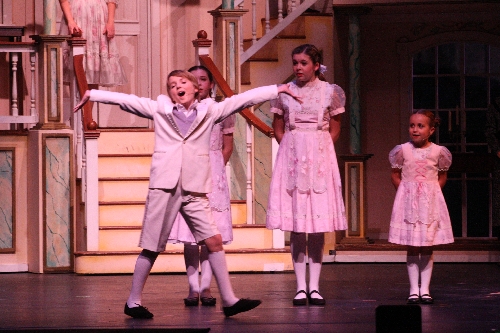Drawing children, teens crucial for community theater’s future
Spare them Shakespeare and Ibsen (for now). Serve them zombies and video games.
Even if it's onstage. Especially if it's onstage.
"Young people need to get exposure, and the key is getting them to the theater," says Walter Niejadlik, president of Las Vegas Little Theatre, who has long fretted over an aging audience that isn't being adequately refreshed by the under-30 crowd. "Their image of theater is someone speaking Shakespeare, a long, boring, stodgy, antiquated art form."
Demographically, many local theaters could use a slogan -- say, "Old is still gold, but young is the next rung" -- to get some non-AARP-ers into the seats, behind the scenes and onstage.
Involved. Interested. Invested.
Toward that end, meet "Neighborhood 3: Requisition of Doom," opening Friday at LVLT's Black Box. "This really underlines it; it's about a video game and zombies and is more of a commentary about life today," Niejadlik says. "It has themes that play to a younger audience."
Students at Las Vegas Academy and the junior thespians of Rainbow Company are already hooked into theater. Yet enough stereotypes exist among community kids to erect powerful walls between them and the theater experience, particularly in our faster-than-ever, convenience-seeking, media-bombardment culture:
It's elitist, slow and visually uninteresting compared to special effects and 3-D movies. You have to see it on the theater's schedule, not yours, while movies play repeatedly morning till night. You have to break for intermissions. You don't know what you're getting, as opposed to movies featuring familiar stars. It's mostly for gay kids, or so viewers of Fox's "Glee" might believe.
As opposed to the freedom of one's living room while TV watching (and unfortunately, many movie theaters), in which to clown around, you've got to sit still. Pay attention. Act up and it's not only fellow theatergoers, but actors who might throw you killer looks. You have to practice consideration for others.
Hopelessly old-fashioned, no?
"It's not as flashy or bloody or in your face as movies and TV, and I think kids are a little jaded," Niejadlik says.
Pluses? As an audience member, it's an old defense that is forever true: When well-done, the electricity of a live show is unmatchable. As actors, you're required to embody characters and face circumstances you wouldn't otherwise, making you empathetic to different kinds of people. Or turn the experience inward.
"I'm relatively new -- OK, I'm incredibly new," says 18-year-old Aly Thomas, who performed in Signature Productions' "Little Shop of Horrors" and will debut in "Requisition of Doom" with fellow teen Dakota Granados. "But being onstage, the energy and adrenaline it brings. It's not so much being someone else, but exploring new parts of yourself that I thought was so cool. It's self-discovery, but it's not self-indulgent."
Theater also is similar to school sports in its reliance on teamwork from people who are the equivalent of different position players -- actors, crew members, directors, designers, writers, musicians.
"It's of paramount concern, you've got to grow your audience," says Phil Shelburne, director of PS Productions, producer of many shows featuring kids, including "Joseph and the Amazing Technicolor Dreamcoat," "Oliver" and "Willy Wonka and the Chocolate Factory." Though recruiting children via everything from school announcements to Craigslist, Shelburne says that "I don't have anything with kids right now and that's a bone of contention. I have pitched shows with children's involvement and nothing's been picked up."
What would spur youth participation? "Having youth programs is something a lot of theater companies have added in the last decade," says Julie Crawford, executive director of the American Association of Community Theatre. "Youth programs tend to pay for themselves and can help cover some overhead. You can raise money for scholarships from sponsors, who might not otherwise give you money to do a mainstage show."
Here? Beyond being an uncoordinated market -- no theater guild links local companies to address common issues, as exists in many cities -- a group effort to enlist young people also is missing. "Last year we talked about this very strongly, creating an outreach," Shelburne says. "It didn't go anywhere."
When he cast youngsters, Shelburne says, it pays dividends. "You usually pick up some of their friends, the support of the family, so you reach a lot more people when you work with younger talent. The experience is magnified."
One company, known for family shows and audiences, has no problem attracting kids. "When we did 'Sound of Music' auditions last year, we had 170 children show up," says Leslie Fotheringham, Signature's artistic director. "I don't know about these other companies, but we've never had a problem. It could be that through the years, our list is long and it's a combination of senior patrons and family patrons."
One of the kids who made "The Sound of Music" cut -- as well as "The King & I" and "Willy Wonka" with PS -- is 12-year-old Jackson Langford. "It's really fun," he says. "If you make a mistake you get to play off it and learn from it, and the audience keeps you comfortable."
Has he spread the theater gospel to his peers? "I just don't think they know about it," he says. "I guess the word doesn't get out. I try to express that it's really fun, but nobody seems to get it. But it's really fun to inspire people."
Though some efforts at LVLT haven't borne fruit -- a Saturday matinee program offering free tickets to high school and college students hasn't found funding -- there have been encouraging signs. "The best tool we have now is social media," Niejadlik says. "When we did 'Dirty Rotten Scoundrels,' most of the crew was late high school or college. It was a much younger crew than we normally have, and they were very reliable and had a lot of fun. Some have already been recruited for other shows this season."
All the world's a stage? Let's hope more kids find the stage door.
Contact reporter Steve Bornfeld at sbornfeld@reviewjournal.com or 702-383-0256.


















